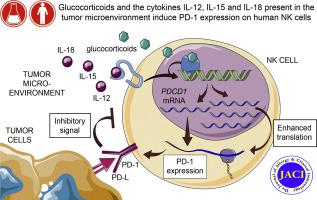Journal of Allergy and Clinical Immunology ( IF 11.4 ) Pub Date : 2020-05-14 , DOI: 10.1016/j.jaci.2020.04.044 Linda Quatrini 1 , Paola Vacca 1 , Nicola Tumino 1 , Francesca Besi 1 , Anna Laura Di Pace 1 , Francesca Scordamaglia 2 , Stefania Martini 3 , Enrico Munari 4 , Maria Cristina Mingari 5 , Sophie Ugolini 6 , Lorenzo Moretta 1

|
Background
Programmed cell death protein 1 (PD-1)–immune checkpoint blockade has provided significant clinical efficacy across various types of cancer by unleashing both T and natural killer (NK) cell–mediated antitumor responses. However, resistance to immunotherapy occurs for many patients, rendering the identification of the mechanisms that control PD-1 expression extremely important to increase the response to the therapy.
Objective
We sought to identify the stimuli and the molecular mechanisms that induce the de novo PD-1 expression on human NK cells in the tumor setting.
Methods
NK cells freshly isolated from peripheral blood of healthy donors were stimulated with different combinations of molecules, and PD-1 expression was studied at the mRNA and protein levels. Moreover, ex vivo analysis of tumor microenvironment and NK cell phenotype was performed.
Results
Glucocorticoids are indispensable for PD-1 induction on human NK cells, in cooperation with a combination of cytokines that are abundant at the tumor site. Mechanistically, glucocorticoids together with IL-12, IL-15, and IL-18 not only upregulate PDCD1 transcription, but also activate a previously unrecognized transcriptional program leading to enhanced mRNA translation and resulting in an increased PD-1 amount in NK cells.
Conclusions
These results provide evidence of a novel immune suppressive mechanism of glucocorticoids involving the transcriptional and translational control of an important immune checkpoint.
中文翻译:

存在于肿瘤微环境中的糖皮质激素和细胞因子IL-12,IL-15和IL-18诱导人自然杀伤细胞上PD-1的表达。
背景
通过释放T和自然杀伤(NK)细胞介导的抗肿瘤反应,程序性细胞死亡蛋白1(PD-1)-免疫检查点封锁已在各种类型的癌症中提供了显着的临床疗效。但是,许多患者对免疫疗法产生抗药性,使得控制PD-1表达的机制的识别对于提高对疗法的反应极为重要。
目的
我们试图确定在肿瘤环境中诱导人NK细胞上从头PD-1表达的刺激和分子机制。
方法
用不同的分子组合刺激从健康供体外周血中新鲜分离的NK细胞,并在mRNA和蛋白质水平上研究PD-1的表达。此外,进行了肿瘤微环境和NK细胞表型的离体分析。
结果
糖皮质激素与人类肿瘤细胞上丰富的细胞因子结合,对人NK细胞的PD-1诱导是必不可少的。从机理上讲,糖皮质激素与IL-12,IL-15和IL-18一起不仅上调PDCD1转录,而且还激活以前无法识别的转录程序,从而导致mRNA翻译增强,并导致NK细胞中PD-1含量增加。
结论
这些结果提供了糖皮质激素的新型免疫抑制机制的证据,该机制涉及重要免疫检查点的转录和翻译控制。









































 京公网安备 11010802027423号
京公网安备 11010802027423号